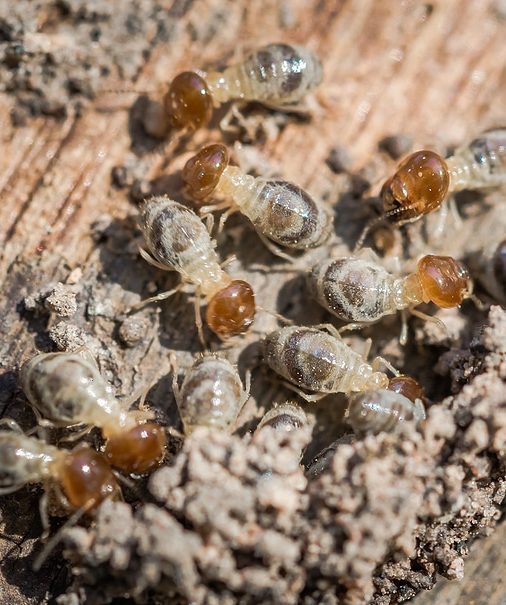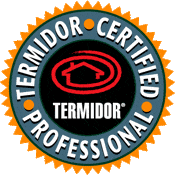Are termites more destructive today than in the past?
News reports of devastating termite damage, homes lost to wood destroying termites, lawsuits against unscrupulous pest control companies and distressed families are commonplace today.
Insurance carriers, engineers and building inspectors are determining structural loss following major storms are connected to structures weakened by wood destroying termites. Termites weaken trees and buildings which makes it easier for trees and walls to collapse. Increasingly, insurance carriers are using this information to deny or limit claims; many property owners are dismayed to learn their negligence in maintaining the property can be used against them.
Damage caused by termites is on the rise and there are five main reasons why:
1. We have new species of termites to deal with.
Florida is home to many native and imported termite species. Two imported species are causing a great deal of alarm with termite treatment professionals:

Coptotermes formosanus or Formosan subterranean termites were imported into the US following WWII. Formosan termites are larger and more destructive than our native Eastern subterranean termites. Their territory has expanded, and they now cover most parts of Florida. Controlling Formosan termites is more difficult as they build satellite nests within our buildings and trees.
The Asian-Formosan hybrid subterranean termite was first observed around 2015 when researchers with the University of Florida observed the termites mating in SE Florida. Formosan female termites produce ten times the sex pheromone as the female Asian termite so Asian males are selecting Formosan females for mating.
Both species are highly destructive to our homes and buildings.
2. The materials we use to construct our homes and buildings have changed.
One important change is the size and quality of our framing lumber.
Nominal size (2 x 4) is not actual size (1.5 x 3.5) thus, what was once a 2″ x 4″ board is now less. While our architects and Builders can make a case it meets structural standards for load bearing and wind resistance, it is easy to see it also means it can be rendered structurally deficient in a shorter time when termites infest the wood; there is simply less wood.
Further, modern wood framing is simply not as good as it once was. At the turn of the century, most framing lumber was made of aged, hardwood such as oak. Today our lumber is made of softwoods like fir, hemlock, spruce or pine. Softwoods grow faster than hardwoods and hardwoods are denser. The density of the hardwood is important as it takes termites longer to consume than a softwood.
In summation, we use less wood and softer wood today so it is much easier for termites to inflict major structural damage faster.
3. We have more structures.
Over the past decade we added over 8 million new homes and upwards of 100 billion sf of commercial space and experts predict we will build an average of 13,000 buildings every day through 2050. Many of our new subdivisions and commercial properties are being built on reclaimed land, in historical swamps which are conducive to termite colonies.
4. Our buildings are tighter, and they hold more moisture.
Beginning with the oil embargo in 1973-1974, we began looking for ways to curb energy needs in our homes and buildings. We sought to save energy using tighter construction practices and more energy efficient building materials. The ancillary effect of this goal is our buildings today have less exfiltration of air so when our buildings do get wet, they are hard to dry. Moisture is conducive to termites; damp wood is attractive.
5. Property owners fail to take termite prevention seriously.
Let’s face it, nobody wants to pay for termite prevention. We would much rather spend our money on things we want. For most, we must make choices where we spend our money and we have competing needs and desires for our money. After we pay the mortgage, insurance, car payment, health insurance, clothing, gas, food and the basic necessities, we tend to rationalize what we do with anything left over…entertainment, vacation, investment/savings and maybe home maintenance is considered or maybe it is not; for about 47% of homeowners, it is not.
While this may sound self-serving (we sell termite treatment), let me explain why it should not be overlooked.
Subterranean termites forage up to 300 feet in all directions so when nearly half of your neighbors are exposed to a termite attack, you are too. The odds are not in your favor.
In time, the likelihood your home will be infested by termites is almost guaranteed. Florida is ranked in the top 3 of all states for termite damage.
Your homeowners insurance does not cover damage caused by termites.
In the event your home is structurally damaged by a falling tree or wind event, you are at risk of being denied coverage if the insurance carrier can document the damage was caused by your failure to maintain and protect your home.
How much are you risking by not having your home protected against termites?
The average treatment cost for a home with an infestation is $3,000.
The average cost to repair damage from termites is over $30,000. Repairs exceeding $100,000. are not unusual.
Long term infestations could result in catastrophic damage requiring demolition of the structure.
Damage due to termites is not covered by property insurance coverage. You are on your own.
Buyers are reluctant to purchase homes with known termite damage. Your home maybe devalued or difficult to market should you need to sell.
Protecting your home against termites costs about the same as your daily cup of coffee for most homes (1/3rd less than a double latte). Let’s compare:
| Large coffee at 7-11 | $ 1.29 | Termite plan: $ 0.82 |
| Large coffee at Dunkin Donuts | $ 2.09 | Termite plan: $ 0.82 |
| Double latte at Starbucks | $ 2.95 | Termite plan: $ 0.82 |
| Average Iced Coffee | $ 2.49 | Termite plan: $ 0.82 |
A termite plan costs pennies more than a quality K-cup coffee made at home!
360PestControl provides full-service pest control, termite inspections, termite treatment, lawn & ornamental services across Florida.
William Chandler is an Associate Certified Entomologist and Building Scientist with over 40 years of experience in pest control, mold and moisture investigation, building construction and forensic building investigation. He is a Termite Expert by UF/PMU.







